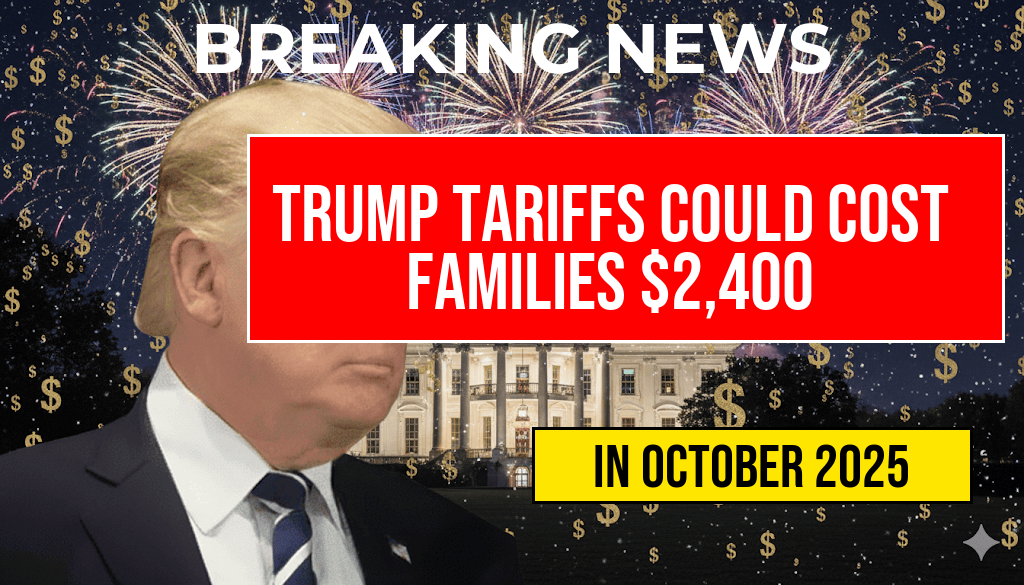Recent discussions surrounding the impact of Trump-era tariffs have shifted from political debates to tangible effects on American households. Analysts estimate that ongoing import taxes could inflate the average family’s annual expenses by approximately $2,400, a figure that underscores the broader economic ripple effects of trade policies often overlooked by consumers. These tariffs, initially introduced to protect certain domestic industries, have inadvertently increased costs across a wide range of goods—from electronics and clothing to food products and automobiles. Despite claims that tariffs bolster local manufacturing, their hidden costs are now becoming evident through rising prices and squeezed household budgets.
The Mechanics of Tariff Costs
Tariffs are taxes imposed on imported goods, intended to make foreign products more expensive and promote domestic production. However, this strategy often results in higher retail prices, which are directly passed down to consumers. According to recent economic analyses, the cumulative effect of these tariffs could be adding roughly $200 to $300 annually to individual household expenses for everyday items. When multiplied across an average family, this translates into an additional burden of about $2,400 per year.
Key Sectors Affected by Tariffs
Electronics and Appliances
- Tariffs on Chinese-made electronics and appliances have led to higher prices for popular items like smartphones, laptops, and refrigerators.
- Manufacturers passing costs onto consumers contribute to increased household spending, especially as electronics are essential for remote work and education.
Clothing and Footwear
- Imported apparel, often sourced from overseas manufacturing hubs, has seen price hikes due to tariffs.
- Shoppers report paying an average of 10-15% more for clothing items, adding up over multiple purchases annually.
Food and Beverages
- Tariffs on agricultural imports, including certain fruits, nuts, and seafood, have led to higher grocery bills.
- Costlier ingredients contribute to increased prices at restaurants and supermarkets alike.
Automobiles and Auto Parts
- Automotive tariffs have raised the cost of imported vehicles and spare parts, impacting car buyers and repair costs.
- For families with vehicles, this can mean hundreds of dollars more annually in maintenance and purchase expenses.
Broader Economic Impacts
Beyond individual price increases, tariffs influence broader economic indicators. Companies facing higher input costs may reduce hiring, delay investments, or pass costs onto consumers. Small businesses, which rely heavily on imported goods or components, are particularly vulnerable, potentially leading to fewer employment opportunities and slower economic growth.
Trade experts warn that persistent tariffs could also provoke retaliatory measures from trading partners, further disrupting supply chains and exacerbating inflationary pressures. The trade war dynamics initiated by tariffs have historically resulted in complex economic shifts, often to the detriment of consumers.
The Hidden Toll on Families
| Item Category | Additional Cost |
|---|---|
| Electronics & Appliances | $600 |
| Clothing & Footwear | $500 |
| Food & Beverages | $700 |
| Automobiles & Parts | $600 |
| Total | $2,400 |
These figures reflect a growing concern among economists and consumer advocates that tariffs, while politically motivated at times, carry real costs for American families. The added expenses diminish disposable income, complicate household budgets, and may slow down economic recovery efforts.
Policy and Consumer Choices
Understanding the full scope of tariff impacts prompts questions about future trade policies and consumer strategies. Some experts suggest diversifying supply chains or seeking alternative suppliers to mitigate costs, though such measures can be complex and costly. Policymakers face increased pressure to balance protecting domestic industries with minimizing the burden on consumers.
Meanwhile, consumers are advised to monitor price fluctuations and explore local alternatives where feasible. Staying informed about trade policy developments can help families anticipate and plan for potential cost increases.
For further insights into how tariffs influence the economy, the Wikipedia article on trade policy offers a comprehensive overview of trade tools and their implications.
Frequently Asked Questions
What are the main financial impacts of the “Turbulence Tax” on families?
The “Turbulence Tax,” driven by Trump tariffs, can add approximately $2,400 annually to a typical family’s expenses, affecting the cost of imported goods, consumer products, and overall household budgets.
How do tariffs increase the cost of everyday items for families?
Tariffs raise the cost of imported goods by imposing additional taxes on imports, which manufacturers often pass on to consumers, leading to higher prices on products like electronics, clothing, and household items.
Are there specific sectors or products most affected by these tariffs?
Yes, sectors such as electronics, apparel, and agricultural products are particularly impacted, with tariffs increasing costs and contributing to the overall “Turbulence Tax” that families pay indirectly.
What can families do to mitigate the financial effects of these tariffs?
Families can consider shopping for alternatives, purchasing domestically produced goods when possible, and budgeting for increased expenses to better manage the additional costs caused by the tariffs.
Will the “Turbulence Tax” continue to affect family expenses in the future?
The impact depends on trade policies and tariff regulations. If tariffs persist or increase, families may see ongoing or heightened costs, making it important to stay informed about policy changes.






